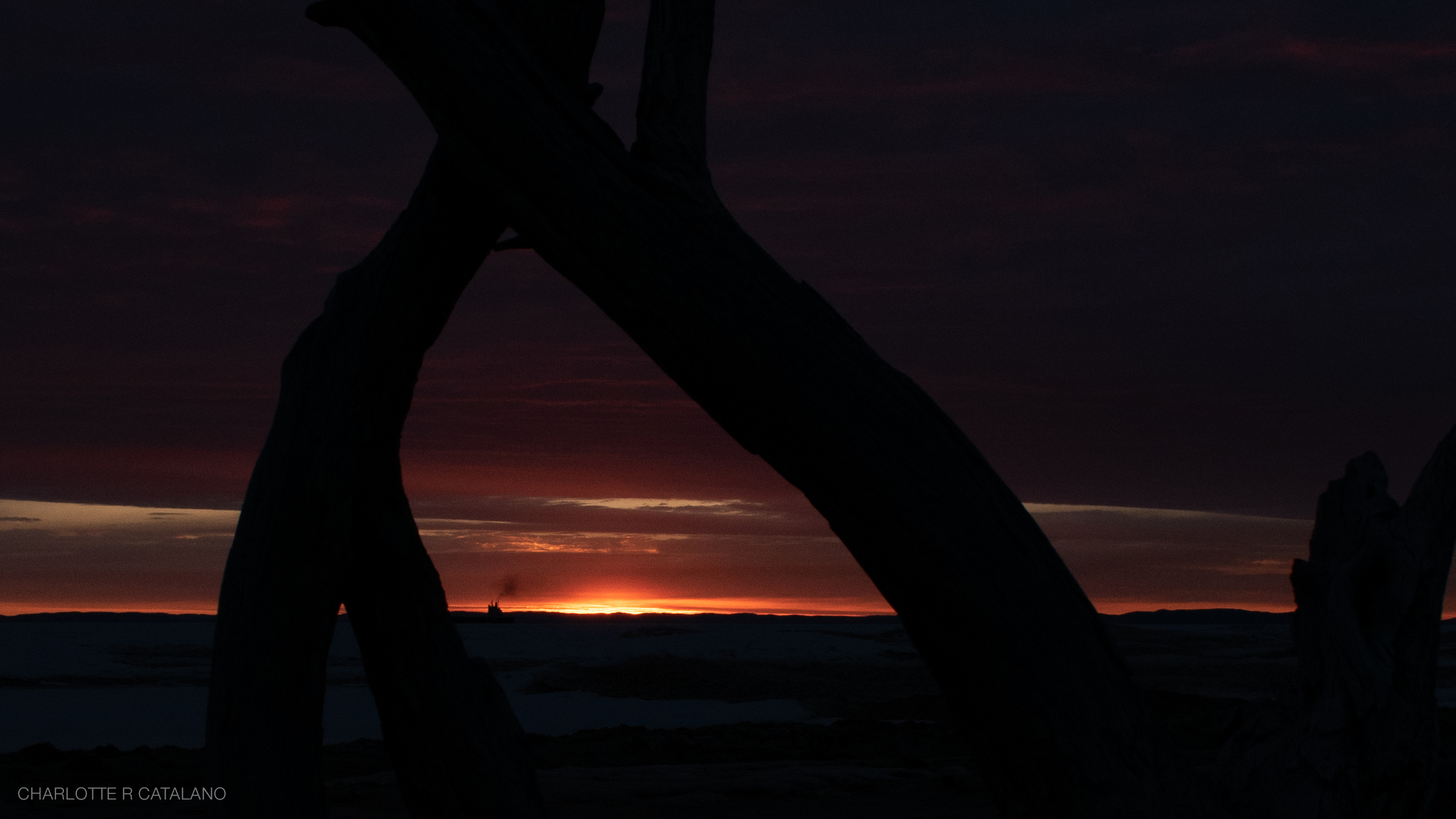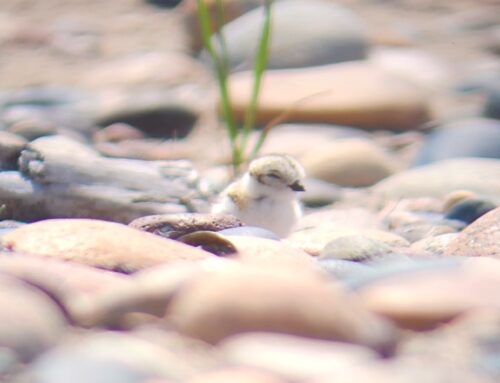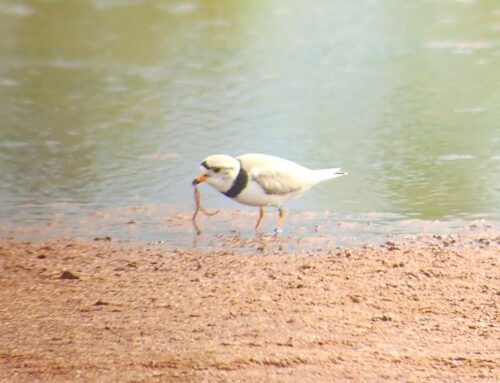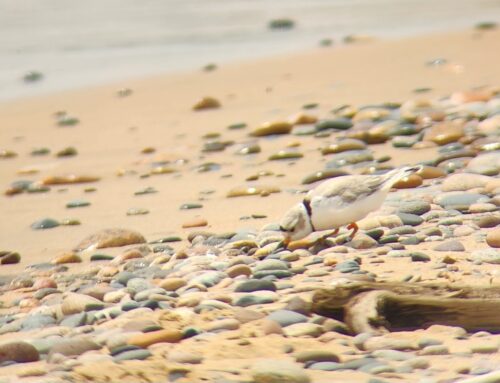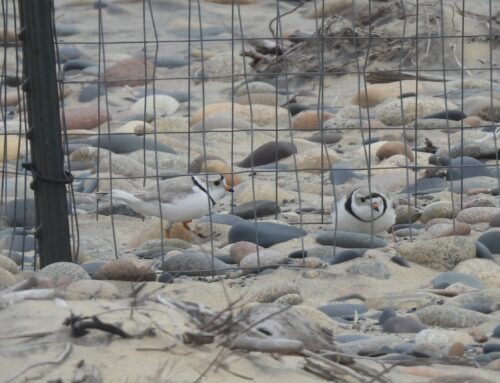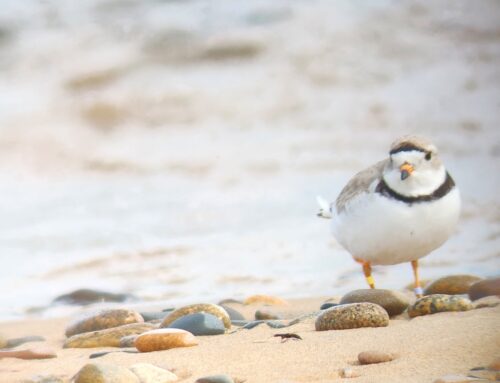Highlights:
Too many to name! Or: Leucistic Red-Tailed Hawk – Spruce Grouse – Increasing Sparrow Diversity – Pine Warbler – Kinglets – Brown Creeper – Pine Siskin – Broad-Winged Hawk – Snowy Owl – Greater Yellowlegs
Just when it seemed like migration might not ever happen, birds started happening in a big way with more and more seeming to fill the skies, trees, and grounds as the days progress. In fact, so many exciting birds have been showing up, it’s hard to pinpoint any particular species or moments.
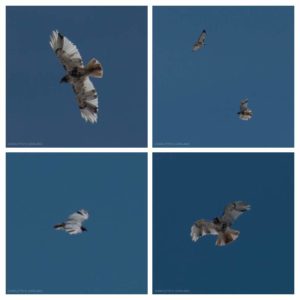
A compilation of the leucistic Red-Tailed Hawk (Buteo jamaicensis) observed on April 15. The top right image displays the leucistic hawk with a typical eastern Red-Tailed Hawk. Photos by Charlotte R. Catalano
Personally, my biggest highlight was seeing my first ever leucistic Red-Tailed Hawk on April 15. Not to be confused with albinism, leucism refers to pigmentation loss in an animal that leads to white coloring in features, skin, hair, or scales, but not eyes. This particular individual (pictured), had some red tail feathers, a patchy brownish belly band, and some coloring to the feathers and elsewhere. The raptor was very cool to see with nice views available through binoculars and the scope. I also saw a second, definitively different leucistic red-tailed at the watch on April 24.
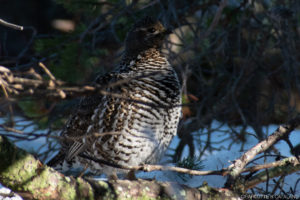
A female Spruce Grouse (Falcipennis canadensis), a very uncommon visitor to the Point, spotted within sight of the waterbird shack. Photo by Charlotte R. Catalano
In competition with the red-tailed sighting, I saw my very first Spruce Grouse in the woods within sight of the waterbird shack. While these birds are common just south of the Point, they are exceedingly rare at the Point itself with many years passing by without a sighting. The Spruce Grouse is one of the most beautiful gallinaceous birds I have seen, their plumage a myriad of subtle browns and white that helps blend them into their environment. I sincerely hope anyone who wants to see one of these birds in their lifetime gets the opportunity as I cannot see them being disappointed.
Sparrow diversity is growing greatly with Dark-eyed Junco, Chipping, Savannah, Fox, White-throated, American Tree, and Song Sparrow all observed at the feeders on the same day and all but the chipping seen at the same time. The first Pine Warbler was seen eating suet the same day as “Sparrowmania” began.
Common Redpoll have been severely declining over the past several days while Dark-eyed Junco are seemingly everywhere. Additionally, Golden-crowned Kinglet and Ruby-crowned Kinglet have shown up in recent days and Brown Creeper are fairly easy to come by now.
Broad-winged Hawk at long-last showed up at the hawk deck on April 24 to the great enjoyment of all.
Common Loon have been continuing to come through, with a special showing on the morning of April 24 as a few of these wonderful birds called as they flew by.
A nice flock of 16 Greater Yellowlegs stopped over for a short time in the wetland at the tip of the Point on April 22 before carrying on across the lake.
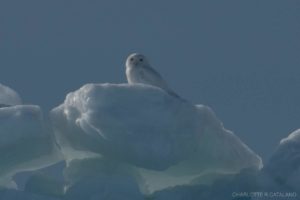
A Snowy Owl (Bubo scandiacus) on a Lake Superior ice floe at Whitefish Point. Photo by Charlotte R. Catalano
A Snowy Owl, the season’s first (and potentially only), was observed perched on ice floes along the edge of the Point on April 19.
To digress a little, can I just say there is absolutely nothing like pulling into the Whitefish Point parking lot, looking up, and seeing hawks everywhere? Because there’s nothing like pulling into the Whitefish Point parking, looking up, and seeing hawks everywhere. I’ve been granted the opportunity to have this experience a few times now and each time I’m left in awe, whether it be Red-Tailed Hawk or Sharp-Shinned Hawk. These experiences are definitely lifelong takeaway memories for me.
I find that rainstorms can bring about some of the best birding if you’re willing to tough it out. On April 22, I was covering the waterbird count with most of the day passing by with prolonged bouts of rain. Unlike many other birds, waterbirds are apt to fly in rain. However, every time the skies cleared for any period of time, numerous other types of birds took to the sky or began foraging in earnest. Northern Harrier, in particular, kept taking advantage of the breaks in rain, coming out of the woodwork and flying up the dunes and over the lake with up to eight visible at once on April 22 and 63 total counted that day, most during the longest bout without rainfall. At one point I turned around in the waterbird shack and could see a Northern Harrier’s eyeballs it flew so close to me! To put it simply, I liken the sky clearing after rain to birding at dawn, and I highly recommend finding your way outside, whether to an urban park, a national forest, the Point, or your own backyard following a bout of inclement weather.
That’s all from me for now. I hope to be seeing and meeting many of you this weekend at Spring Fling!
– Charlotte R. Catalano, WPBO Field Ornithologist
Featured Image: Sunrise at the Point. Photo by Charlotte R. Catalano

